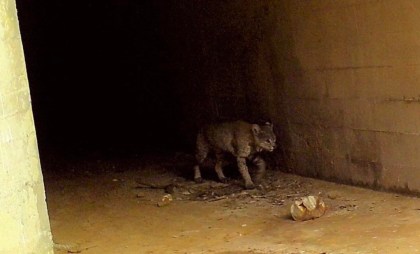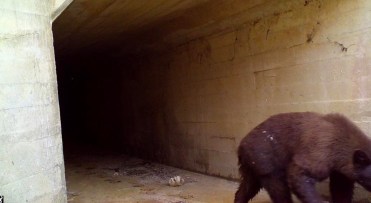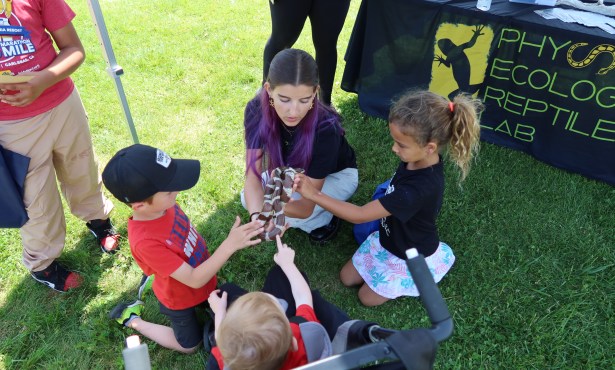Underground Wildlife Crossing Dispute Renewed
Two Gaviota Groups Appeal to Coastal Commission over Caltrans Project

Two environmental organizations based in Gaviota have followed up the loss of their county-level appeal to reconfigure a culvert going in beneath the 101 highway with an appeal to the Coastal Commission. At stake is a wildlife crossing in an area that the Gaviota Coast Conservancy and the Coastal Ranches Conservancy call a roadkill hotspot. Though Caltrans agreed to fund a wildlife survey in the area to find out more about where the wildlife cross the freeway to get from the mountains to the beach, the two nonprofits believe the project that was approved at Cañada del Barro is the right place for Caltrans to create a larger wildlife underpass.
During the appeal hearing at the Board of Supervisors on September 22, Caltrans specialist Mitch Dallas argued that a passageway bored under the highway large enough to accommodate wildlife would raise the current $7.5 million cost to $29.5 million for an 18-foot diameter culvert 450 feet long.

The strategy is often to estimate a price that’s startling, said Doug Kern, head of the Gaviota Coast Conservancy. He had checked with engineers, too. “It doesn’t have to be a mammoth, cavernous way for deer to get though. It just has to be big enough so that they can see light.”
He also took issue with Dallas’s claim that the project is too steep for wildlife. “The steep slope argument didn’t quite make sense,” Kern said. “Just look at the mountains along the Gaviota Coast. They’re steep.”
Get the top stories in your inbox by signing up for our daily newsletter, Indy Today.
The culvert now at Cañada del Barro is failing, and Caltrans intends to place a new one nearby that’s six feet wide. The location is just east of Gaviota State Park, and the agency’s wildlife study found little evidence that the existing culvert was in regular use by wild animals.
The Coastal Ranches Conservancy disagreed, stating that Caltrans’ 78-hour study of the area failed to notice it had wetlands, a perennial stream, or paw prints crisscrossing through and around both ends of the culvert. It also cited a UC Davis study by the Road Ecology Center that found, “The amount of road-killed wildlife in the project vicinity is one of the highest in the whole state of California.”

The conservancy put trail cameras at the culvert exits and viewed a black bear, a skunk, and a bobcat coming out of the tunnel. “Deer also frequent the area, attracting the mountain lions that are often struck and killed on the adjacent highway,” the conservancy stated.
The appeal requests the culvert size be enlarged from six to 12 feet, at an estimated 20 percent increase in cost, or $1.5 million.
Caltrans spokesperson Jim Shivers said the agency maintained that the location was not suitable for an animal crossing. It “demonstrated some of the lowest vehicle-animal conflict within the cited study area,” he stated. Caltrans had vetted a hypothetical crossing and came up with the “18-foot culvert to accommodate deer passage with a 12-foot clearance above a natural flat floor.”
He also noted that the appropriate time for such a debate had been during public comment in the summer of 2018 before the draft environmental document and plans had been prepared. Neither of the appealing parties had sent a comment or suggested changes. As for the wildlife survey, Caltrans was writing a consultant task order for the studies to begin in the spring, Shivers said.
For its part, the Gaviota Coast Conservancy pointed to another wildlife corridor report from UC Santa Barbara that documented the paths used by wildlife under and sometimes over the highway. Two of the park’s five acres that Caltrans planned to buy for the project carried deed restrictions for open space, habitat restoration, and habitat conservation, as well. Trails that are mapped for the area are also lacking from Caltrans plans, the group charged.
Shivers had earlier stated that the agency had already received a coastal permit from the Coastal Commission for the work. Kern replied that that permit was issued before the new information on the actual use of the culvert by wildlife had been established by their research.
“We recognize the need to repair the highway,” Kern said, “and the appeal is not intended to hold up the work. … We checked with engineers to find something reasonable, and that’s where we came up with 12 feet” as a wildlife-friendly and less expensive width for the culvert.
Every day, the staff of the Santa Barbara Independent works hard to sort out truth from rumor and keep you informed of what’s happening across the entire Santa Barbara community. Now there’s a way to directly enable these efforts. Support the Independent by making a direct contribution or with a subscription to Indy+.




You must be logged in to post a comment.